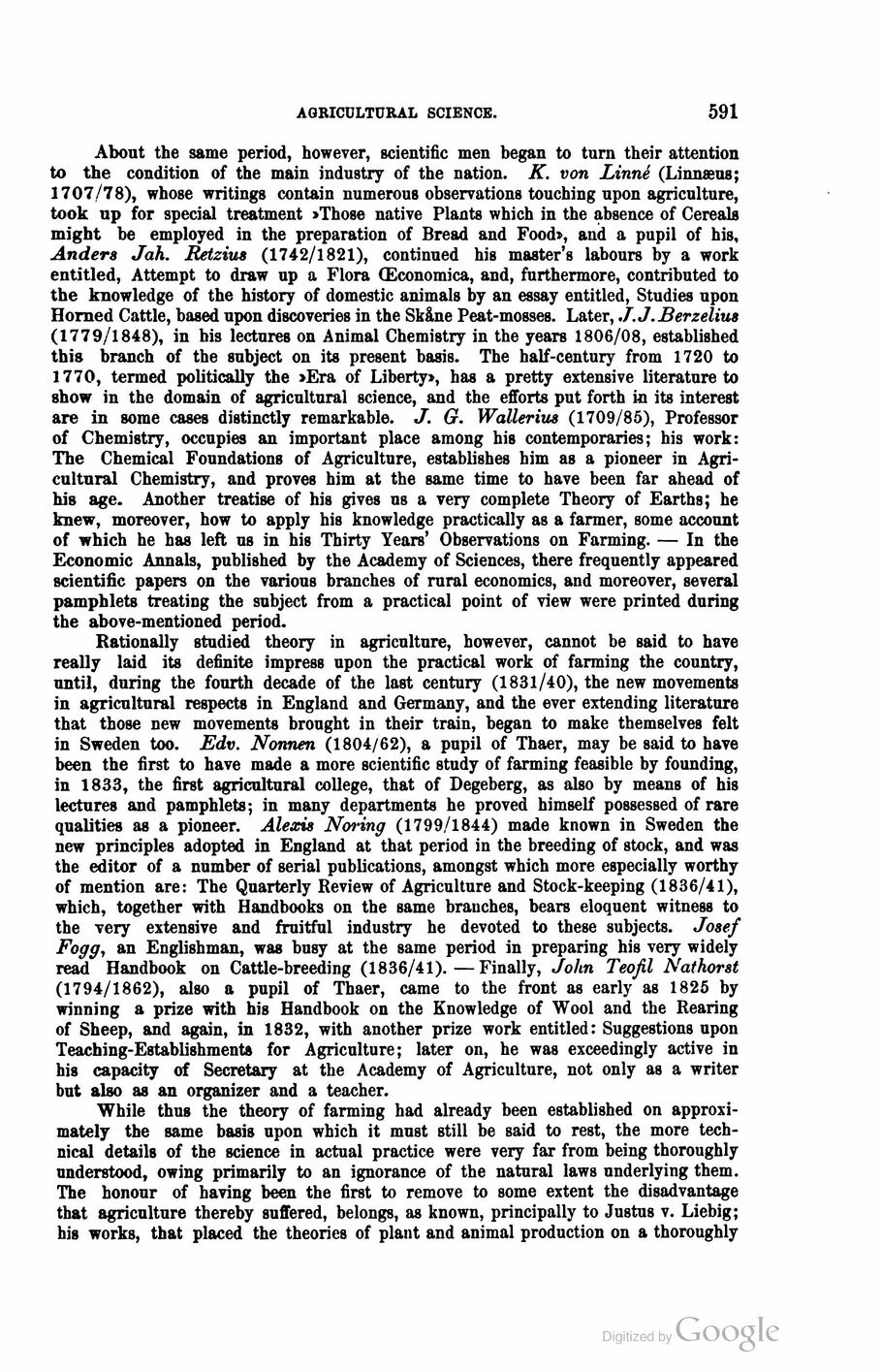
Full resolution (JPEG) - On this page / på denna sida - Second part - VI. Agriculture and Cattle-Breeding - 4. Public and Private Institutions to the Advancement of Agriculture - Agricultural Science, by Prof. H. Winberg, Ph. D., Director of the Alnarp Agricultural High School

<< prev. page << föreg. sida << >> nästa sida >> next page >>
Below is the raw OCR text
from the above scanned image.
Do you see an error? Proofread the page now!
Här nedan syns maskintolkade texten från faksimilbilden ovan.
Ser du något fel? Korrekturläs sidan nu!
This page has never been proofread. / Denna sida har aldrig korrekturlästs.
AGRICULTURAL SCIENCE.
591
About the same period, however, scientific men began to turn their attention
to the condition of the main industry of the nation. K. von Linné (Linnaeus;
1707/78), whose writings contain numerous observations touching upon agriculture,
took up for special treatment »Those native Plants which in the absence of Cereals
might be employed in the preparation of Bread and Food», and a pupil of his.
Anders Jah. Retzius (1742/1821), continued his master’s labours by a work
entitled, Attempt to draw up a Flora (Economica, and, furthermore, contributed to
the knowledge of the history of domestic animals by an essay entitled, Studies upon
Horned Cattle, based upon discoveries in the Skåne Peat-mosses. Later, J. J. Berzelius
(1779/1848), in his lectures on Animal Chemistry in the years 1806/08, established
this branch of the subject on its present basis. The half-century from 1720 to
1770, termed politically the »Era of Liberty», has a pretty extensive literature to
show in the domain of agricultural science, and the efforts put forth in its interest
are in some cases distinctly remarkable. J. G. Wallerius (1709/85), Professor
of Chemistry, occupies an important place among his contemporaries; his work:
The Chemical Foundations of Agriculture, establishes him as a pioneer in
Agricultural Chemistry, and proves him at the same time to have been far ahead of
his age. Another treatise of his gives us a very complete Theory of Earths; he
knew, moreover, how to apply his knowledge practically as a farmer, some account
of which he has left us in his Thirty Years’ Observations on Farming. — In the
Economic Annals, published by the Academy of Sciences, there frequently appeared
scientific papers on the various branches of rural economics, and moreover, several
pamphlets treating the subject from a practical point of view were printed during
the above-mentioned period.
Rationally studied theory in agriculture, however, cannot be said to have
really laid its definite impress upon the practical work of farming the country,
until, during the fourth decade of the last century (1831/40), the new movements
in agricultural respects in England and Germany, and the ever extending literature
that those new movements brought in their train, began to make themselves felt
in Sweden too. Edv. Nonnen (1804/62), a pupil of Thaer, may be said to have
been the first to have made a more scientific study of farming feasible by founding,
in 1833, the first agricultural college, that of Degeberg, as also by means of his
lectures and pamphlets; in many departments he proved himself possessed of rare
qualities as a pioneer. Alexis Noring (1799/1844) made known in Sweden the
new principles adopted in England at that period in the breeding of stock, and was
the editor of a number of serial publications, amongst which more especially worthy
of mention are: The Quarterly Review of Agriculture and Stock-keeping (1836/41),
which, together with Handbooks on the same branches, bears eloquent witness to
the very extensive and fruitful industry he devoted to these subjects. Josef
Fogg, an Englishman, was busy at the same period in preparing his very widely
read Handbook on Cattle-breeding (1836/41).—Finally, Jolin Teofil Nathorst
(1794/1862), also a pupil of Thaer, came to the front as early as 1825 by
winning a prize with his Handbook on the Knowledge of Wool and the Rearing
of Sheep, and again, in 1832, with another prize work entitled: Suggestions upon
Teaching-Establishment» for Agriculture; later on, he was exceedingly active in
his capacity of Secretary at the Academy of Agriculture, not only as a writer
but also as an organizer and a teacher.
While thus the theory of farming had already been established on
approximately the same basis upon which it must still be said to rest, the more
technical details of the science in actual practice were very far from being thoroughly
understood, owing primarily to an ignorance of the natural laws underlying them.
The honour of having been the first to remove to some extent the disadvantage
that agriculture thereby suffered, belongs, as known, principally to Justus v. Liebig;
his works, that placed the theories of plant and animal production on a thoroughly
<< prev. page << föreg. sida << >> nästa sida >> next page >>